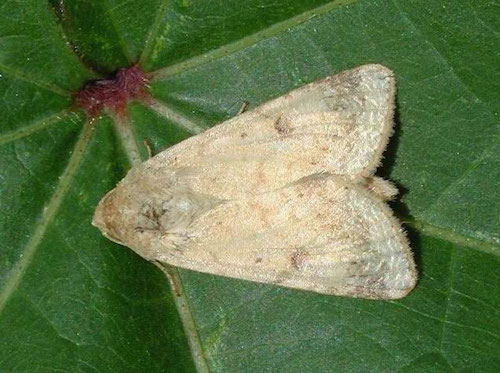Cotton Bollworm
Helicoverpa zea.
The cotton bollworm (a.k.a. corn earworm or sorghum headworm) is a serious pest in the southern cotton growing areas. Infestations of cotton are sometimes observed in Kansas, although damage is usually limited, even when corn and grain sorghum develop heavy infestations. However, the potential for economic damage exists, so growers should watch for infestations that develop during fruiting and boll development.
|
Adult moth. |
Bollworm larva on boll. |
The adult is a medium-sized, cream-colored moth and is seen frequently throughout the day during periods of heavy infestations. Moths lay eggs singly, mostly on the young terminal leaves, and sometimes on leaves and squares within the canopy. Eggs are the size of a pinhead, white to cream colored and hatch in two or three days during warm weather. They are a preferred food of the inisidous flower bug, Orius insidiosus, which can provide some biological control. Young larvae are difficult to find until they are about three to four days old. At this stage, they are about ¼ inch long and brownish colored with some scattered hairs. The full-grown larva is about 1½ inches long with a light-colored head capsule. The predominant body color may range from pink or green to various shades of tan or dark brown. A series of dark stripes run lengthwise on the body. Larvae begin feeding on leaf tissue and small squares, then move down the plant and damage the larger squares and bolls.
Bollworm management is based on scouting for eggs and small larvae. Treatment is recommended when there are 10 eggs, or five small larvae, per 100 plants during early bloom in late July and early August. Preventative treatments during the pre-bloom period are discouraged, because they will kill many beneficial arthropods that provide natural biological control of bollworms and other pests. Chemical control is seldom effective after larvae are more than ½ inch long (third instar). Once the cotton has blooms within four to five nodes of the top of the plant, there is usually no longer any need for bollworm control. However, in some cases these late blooms can add to final yields and treatment may be justified if populations are heavy and the weather remains favorable.
Many commercial cotton varieties express Bt traits that are toxic to lepidopteran larvae, but the need for this technology, and value of paying extra for it, is questionable in Kansas given the generally low levels of bollworm infestation. Bollworms must ingest the Bt toxins and it can take up to five days for death to occur. Infected larvae lose their appetite and stop feeding within hours, although larger larvae often have better survival. Different scouting techniques and economic thresholds must be employed in Bollgard™ cotton. Shorten scouting intervals to two to three days during periods of heavy oviposition to determine if newly hatched larvae are being controlled. Although many H. zea populations now express resistance to the original Bt event, most modern Bt cultivars express multiple Bt proteins to overcome this problem, at least for now. Consider spraying if excessive fruit and boll damage are noticed and there are 10 or more small larvae (¼ to 3/8 inch long) per 100 plants, or six small larvae in 100 flowers selected at random.
Please refer to the most recent version of the Cotton Insect Management Guide for specific control recommendations.
Page last updated 5/131/2024 by J.P. Michaud.

